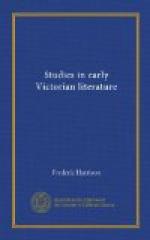Sartor Resartus (1831), the earliest of his greater works, is unquestionably the most original, the most characteristic, the deepest and most lyrical of his productions. Here is the Sage of Craigenputtock at his best, at his grimmest, and, we must add, in his most incoherent mood. To make men think, to rouse men out of the slough of the conventional, the sensual, the mechanical, to make men feel, by sheer force of poetry, pathos, and humour, the religious mystery of life and the “wretchlessness of unclean living”—(as our Church article hath it)—nothing could be more trumpet-tongued than Sartor. The Gospel according to Teufelsdroeckh is, however, a somewhat Apocalyptic dispensation, and few there be who can “rehearse the articles of his belief” with anything like precision. Another and a more serious difficulty is this. How many a “general reader” steadily reads through Sartor from cover to cover? And of such, how many entirely understand the inner Philosophy of Clothes, and follow all the allusions, quips, and nicknames of Sartorian subjectivity. It would be a fine subject for some Self-Improvement Circle of readers to write examination papers upon questions as to the exact meaning of all the inward musings of Teufelsdroeckh. The first class of successful candidates, one fears, would be small. A book—not of science or of pure philosophy, or any technical art whatever—but a book addressed to the general reader, and designed for the education of the public, and which can be intelligently digested and assimilated by so very few of the public, can hardly be counted as an unqualified success. And the adepts who have mastered the inwardness of Sartor are rare and few.
The French Revolution, however, is far more distinctly a work of art than Cromwell, and far more accessible to the great public than Sartor. Indeed the French Revolution is usually, and very properly, spoken of and thought of, as a prose poem, if prose poem there can be. It has the essential character of an epic, short of rhythm and versification. Its “argument” and its “books”; its contrasts and “episodes”; its grouping of characters and denoument—are as carefully elaborated as the Gerusalemme of Tasso, or the Aeneid of Virgil. And it produces on the mind the effect of a poem with an epic or dramatic plot. It is only a reader thoroughly at home in the history of the time, who can resist the poet’s spell when, at the end of Part III., Book VII., he is told that the Revolution is “ended,” and the curtain falls. As a matter of real history, this is an arbitrary invention. For the street fight on the day named in the Revolutionary Calendar—13 Vendemiaire, An 4 (5th October 1795), is merely a casual point in a long movement, at which the poet finds it artistic to stop. But the French Revolution does not stop there, nor did the “Whiff of Grapeshot” end it in any but an arbitrary sense. When the




